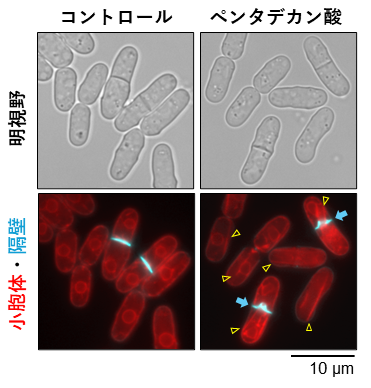2025-05-30 広島大学

図1.巨大ERシートの蛍光顕微鏡観察像.分裂酵母に小胞体に局在する蛍光タンパク質を発現させ(赤)、また、蛍光色素(青)を添加して細胞分裂時に合成される細胞壁(隔壁)を可視化している。ペンタデカン酸を添加すると巨大ERシートが現れる(黄色の矢頭)。また、隔壁がハの字型に変形し、細胞分裂が邪魔されている細胞が観察される(青矢印)。
<関連情報>
ペンタデカン酸による巨大ERシートの形成が分裂酵母の脂質毒性を引き起こす Formation of giant ER sheets by pentadecanoic acid causes lipotoxicity in fission yeast
Yojiro Hoshikawa, Natsuho Shirota, Hiroshi Tsugawa https://orcid.org/0000-0002-2015-3958, +7 , and Shinichi Nishimura
Proceedings of the National Academy of Sciences Published:May 27, 2025
DOI:https://doi.org/10.1073/pnas.2422126122
Significance
Although fatty acids (FAs) are essential for living organisms, excess amount causes sickness through cell and tissue dysfunction and cell death, a phenomenon known as lipotoxicity. However, the molecular mechanism underlying lipotoxicity largely remains to be elucidated. Here, we show that pentadecanoic acid exerts toxicity on fission yeast by generating an aberrantly planar endoplasmic reticulum (ER) structure, which we name a “giant ER sheet.” Pentadecanoic acid is preferentially incorporated into phospholipids and the unsaturation degree of phospholipids decreases, which should impair proper fluidity of the ER membrane. The giant ER sheet hampers correct migration of cell division sites and physically blocks cell division. The ER is likely the primary site targeted by saturated FAs, leading to lipotoxicity.
Abstract
Excess amounts of saturated fatty acids (FAs) are toxic to organisms, a condition termed lipotoxicity, which is often accompanied by pleiotropic cellular and tissue dysfunction. Here, we show that pentadecanoic acid (C15:0) exerts toxicity on the fission yeast Schizosaccharomyces pombe by generating an aberrantly planar endoplasmic reticulum (ER) structure, which we named a “giant ER sheet.” Untargeted lipidomics revealed that C15:0 is incorporated into complex lipids depending on an acyl-CoA ligase Lcf1 and an acyl-CoA transferase Slc1, thereby increasing the saturation level of the acyl chains. The toxicity and giant ER sheet formation were abolished by deleting lcf1 or slc1 gene, indicating that the incorporation of C15:0 into glycerophospholipids causes giant ER sheet formation. The giant ER sheets disrupted the correct migration of Mid1, a protein determining the cell division site, and physically blocked septum formation, hindering correct cell separation. Our results suggest that the ER is the primary site targeted by saturated FAs, leading to lipotoxicity.

